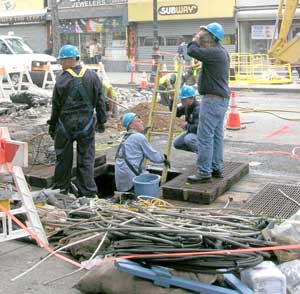First outage, then outrage in Queens, N.Y.
By
Mary Owen
LeiLani Dowell
New York
Published Jul 27, 2006 10:24 PM
Large
sections of the Astoria, Sunnyside, Woodside and Long Island City communities in
the Queens borough of New York City have had low or no power since July 17.
During a week of both stifling heat and torrential rains, some 100,000 people
were affected. Like the response in New Orleans following Hurricane Katrina,
people were left to fend for themselves for several days.
|
Utility workers laying new cable on Steinway Street,
a normally crowded shopping
hub.
WW photo: Mary Owen
|
Queens is a
predominantly working class area with a large immigrant population. Many believe
that it was initially ignored because of its demographics and class
background—unlike the immediate response to ritzy Manhattan areas when
there is an outage.
It took four days before officials would even
recognize this major outage in Queens. Residents angrily and repeatedly called
the media and government offices to demand they pay attention.
Local
elected officials finally called a news conference, backing residents’
demand that New York City Mayor Michael Bloomberg come to the area. On July 20,
billionaire Bloomberg deigned to respond, likening his presence there to a
“photo op.” (New York Sun, July 21) Later that same day he conceded
to public outrage and held a hast ily organized news conference in
Astoria.
The city’s electric company, Con Edison, had attempted to
minimize the scope of the crisis by announcing that 2,500 customers were
affected—a number it based only on the number of complaint calls received.
Later it upped that number to 26,000. However, the term “customer”
refers to electrical feeds, not actual people served—so that an apartment
building containing hundreds of people is considered only one customer.
In a radio address, Bloomberg said he was “annoyed” by Con
Edison’s initial estimate, adding, “We might have thrown more
resources into the area.” People in Queens are saying that there is no
excuse, calling the outage and the lack of response a major failure of both the
utility company and the government.
Worker
solidarity
Solidarity with the community has been expressed by the
predominantly Black and Latin@ Con Edison workers on the ground—including
workers who come from many other cities in the eastern U.S. They have been
working 12-hour-plus shifts, eating and sleeping in their trucks and then going
back underground to work in dangerous conditions. Workers World spoke to many,
and they all expressed sympathy for the community. Some blamed Con Edison for
the outage, saying it should never have happened.
One worker remembered a
similar outage that affected some 70,000 people in the largely Domin ican
community of Wash ington Heights, in upper Man hattan. He said Con Edison knew
the electrical feed was bad and didn’t act on it. An investigation by the
Public Service Com mission found that “managers had been told to reduce
the operation and maintenance budget in each of the four years leading up to the
[outage].” (ABC7 News)
Community supports
itself
Forced to survive a crisis without government assistance,
people in apartment buildings organized themselves to support each other,
checking each apartment to assess needs and conditions.
Residents also
organized to fight back. On July 22, affected community, labor, peace and
immigrant rights activists held an emergency meeting, launching a campaign
called Power for the People.
Their demands include: compensation for
losses, expenses and lost wages over and above the paltry $350 being offered to
individuals by Con Edison; free power for the length of time the outage lasts,
and no charge for low power; a people’s fact-finding investigation into
the outage, its causes, impact on the communities and plans to prevent future
outages; a first alert as soon as power problems occur; and a community review
board of Con Edison’s emergency response.
The group has started a
community peti tion drive. For more information, visit powerforthepeople.info
or e-mail [email protected]. To volun teer help with petitioning,
call 718-512-5442.
Other major cities are having similar problems. In Cave
Creek, Ariz., water service was disrupted for 2,300 people during a July 21
outage because the water company did not have a backup generator. A power
failure in St. Louis on July 19 affected more than half a million households and
businesses, resulting in the evacuation of many from their homes.
These
outages raise the issue of how social needs are handled under
capitalism—where services like health care and power are considered a
commodity and not a necessity and a right. What many in Queens have learned is
that nothing would have happened if the people didn’t speak out—and
that their ongoing demands for justice will be won in the same fashion.
Mary Owen is a resident of Sunnyside, Queens. This article
was co-written because the outage left her without access to a
working computer.
Articles copyright 1995-2012 Workers World.
Verbatim copying and distribution of this entire article is permitted in any medium without royalty provided this notice is preserved.
Workers World, 55 W. 17 St., NY, NY 10011
Email:
[email protected]
Subscribe
[email protected]
Support independent news
DONATE


